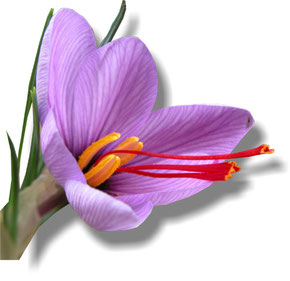Saffron
Identification and origin of Saffron

Scientific name:
Crocus sativus
Saffron is a herbaceous, bulbous plant from the Iridaceae family. It has long, linear green leaves forming tufts.
The parts used are the stigmas and styles terminations.
Its greatest use is as a food coloring and seasoning but its high price has little use and has been replaced by substitutes.
The saffron plant is native to India, the Balkans and the eastern Mediterranean region. It is cultivated in India, Spain, France and Italy.
Content and active ingredients
The main active ingredients of Saffron are:
Carotenoid glycosides: Crocin (giving their tint strength)
Bitter principle: picroside (4%)
Essential oil: safranal (0.4 to 1.3%), traces of cineol.
Fatty acids: olenólico derivatives.
Carotenoids: lycopene, alpha, beta and gamma carotene.
Fixed oil and starch.
Saffron medicinal benefits
The crocin is an active ingredient with marked lipid-lowering effect; the picroside is a bitter substance, with appetizer and eupeptic action.
Saffron also has properties as a nerve stimulant, emmenagogue, and externally, calms dental and gingival pain, is dental analgesic. Its essential oil is carminative, spasmolytic and eupeptic.
This plant is not of high interest in medicine and by its properties is used as a condiment.
Uses of Saffron

Warnings. Notes on use
In very high doses, saffron can be emetic, abortifacient and cause dizziness and severe bleeding.
Abortive dose: 10 g
Lethal dose for adult = 20 g. (poisoning cases come mostly from its use as an abortifacient),is risky to take during pregnancy for their abortive power, produces intoxication and can be lethal in doses of 20 g.
Preparation and Dosage
Internal use:
- Use in food as seasoning.
- Infusion: 2 g / l. One to three cups a day.
- Tincture (1:10): 20-40 drops three times a day, as a carminative.
External use:
- Tincture: apply rubbing the gums.
References
- Dhingra VK et al., (1975) Ind J Chem 13:339.
- Dufresne C, Cormier F, Dorion S, In vitro formation of crocetin glucosyl esters by Crocus sativus callus extract. Planta Med, 16:150-3, 1997 Apr.
- Fenaroli's Handbook of Flavor Ingredients, Vol. 1, 2nd Ed., CRC Press 1975.
- Leung AY, Encyclopedia of Common Natural Ingredients Used in Food Drugs and Cosmetics, John Wiley & Sons Inc., New York 1980.
- Escribano J, Alonso GL, Coca-Prados M, Fernandez JA, Crocinsafranal and picrocrocin from saffron (Crocus sativus L.) inhibit the growth of human cancer cells in vitro. Cancer Lett, 100:23- 30, 1996 Feb 27.
- VADEMECUM DE PLANTAS MEDICINALES.
- PDR for Herbal Medicines, 2nd Edition (2000)

 Pharmacognosy´s topics - Medicinal plants
Pharmacognosy´s topics - Medicinal plants


































Write a comment